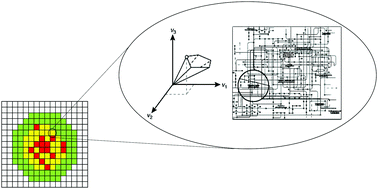当前位置:
X-MOL 学术
›
Mol. Biosyst.
›
论文详情
Our official English website, www.x-mol.net, welcomes your
feedback! (Note: you will need to create a separate account there.)
A multiscale agent-based framework integrated with a constraint-based metabolic network model of cancer for simulating avascular tumor growth
Molecular BioSystems Pub Date : 2017-07-24 00:00:00 , DOI: 10.1039/c7mb00050b Mehrdad Ghadiri 1, 2, 3, 4 , Mahshid Heidari 3, 4, 5, 6, 7 , Sayed-Amir Marashi 3, 4, 5, 6, 7 , Seyed Hasan Mousavi 1, 2, 3, 4
Molecular BioSystems Pub Date : 2017-07-24 00:00:00 , DOI: 10.1039/c7mb00050b Mehrdad Ghadiri 1, 2, 3, 4 , Mahshid Heidari 3, 4, 5, 6, 7 , Sayed-Amir Marashi 3, 4, 5, 6, 7 , Seyed Hasan Mousavi 1, 2, 3, 4
Affiliation

|
In recent years, many efforts have been made in the field of computational modeling of cancerous tumors, in order to obtain a better understanding and predictions of their growth patterns. Furthermore, constraint-based modeling of metabolic networks has become increasingly popular, which is appropriate for the systems-level reconstruction of cell physiology. The goal of the current study is to integrate a multiscale agent-based modeling framework with a constraint-based metabolic network model of cancer cells in order to simulate the three dimensional early growth of avascular tumors. In order to develop the integrated model, a previously published generic metabolic network model of cancer cells was introduced into a multiscale agent-based framework. This model is initiated with a single tumor cell. Nutrients can diffuse through the simulation space and the cells uptake or excrete metabolites, grow, proliferate or become necrotic based on certain defined criteria and flux values of particular reactions. The simulation was run for a period of 20 days and the plots corresponding to various features such as the growth profile and necrotic core evolution were obtained. These features were compared with the ones observed in other (experimental) studies. One interesting characteristic of our modeling is that it provides us with the ability to predict gene expression patterns through different layers of a tumor, which can have important implications, especially in drug target selection in the field of cancer therapy.
中文翻译:

基于多因子代理的框架与基于约束的癌症代谢网络模型相集成,用于模拟血管肿瘤的生长
近年来,在癌性肿瘤的计算模型领域中已经做出了许多努力,以便获得对它们的生长模式的更好的理解和预测。此外,基于约束的代谢网络建模已变得越来越流行,它适合于系统级的细胞生理重建。当前研究的目标是将基于多因子代理的建模框架与基于约束条件的癌细胞代谢网络模型集成在一起,以模拟血管肿瘤的三维早期生长。为了开发集成模型,将先前发布的癌细胞通用代谢网络模型引入了基于多因子代理的框架中。用单个肿瘤细胞启动该模型。营养物可以在模拟空间中扩散,并且细胞会根据特定的定义标准和特定反应的通量值吸收或排泄代谢物,生长,增殖或坏死。模拟进行了20天,并获得了与各种特征(例如生长曲线和坏死核心演化)相对应的图。将这些功能与其他(实验)研究中观察到的功能进行了比较。我们建模的一个有趣特征是,它为我们提供了通过肿瘤不同层预测基因表达模式的能力,这可能具有重要意义,尤其是在癌症治疗领域的药物靶标选择方面。根据某些定义的标准和特定反应的通量值扩散或坏死。模拟进行了20天,并获得了与各种特征(例如生长曲线和坏死核心演化)相对应的图。将这些功能与其他(实验)研究中观察到的功能进行了比较。我们建模的一个有趣特征是,它为我们提供了通过肿瘤不同层预测基因表达模式的能力,这可能具有重要意义,尤其是在癌症治疗领域的药物靶标选择方面。根据某些定义的标准和特定反应的通量值扩散或坏死。模拟进行了20天,并获得了与各种特征(例如生长曲线和坏死核心演化)相对应的图。将这些功能与其他(实验)研究中观察到的功能进行了比较。我们建模的一个有趣特征是,它为我们提供了通过肿瘤不同层预测基因表达模式的能力,这可能具有重要意义,尤其是在癌症治疗领域的药物靶标选择方面。将这些功能与其他(实验)研究中观察到的功能进行了比较。我们建模的一个有趣特征是,它为我们提供了通过肿瘤不同层预测基因表达模式的能力,这可能具有重要意义,尤其是在癌症治疗领域的药物靶标选择方面。将这些功能与其他(实验)研究中观察到的功能进行了比较。我们建模的一个有趣特征是,它为我们提供了通过肿瘤不同层预测基因表达模式的能力,这可能具有重要意义,尤其是在癌症治疗领域的药物靶标选择方面。
更新日期:2017-08-22
中文翻译:

基于多因子代理的框架与基于约束的癌症代谢网络模型相集成,用于模拟血管肿瘤的生长
近年来,在癌性肿瘤的计算模型领域中已经做出了许多努力,以便获得对它们的生长模式的更好的理解和预测。此外,基于约束的代谢网络建模已变得越来越流行,它适合于系统级的细胞生理重建。当前研究的目标是将基于多因子代理的建模框架与基于约束条件的癌细胞代谢网络模型集成在一起,以模拟血管肿瘤的三维早期生长。为了开发集成模型,将先前发布的癌细胞通用代谢网络模型引入了基于多因子代理的框架中。用单个肿瘤细胞启动该模型。营养物可以在模拟空间中扩散,并且细胞会根据特定的定义标准和特定反应的通量值吸收或排泄代谢物,生长,增殖或坏死。模拟进行了20天,并获得了与各种特征(例如生长曲线和坏死核心演化)相对应的图。将这些功能与其他(实验)研究中观察到的功能进行了比较。我们建模的一个有趣特征是,它为我们提供了通过肿瘤不同层预测基因表达模式的能力,这可能具有重要意义,尤其是在癌症治疗领域的药物靶标选择方面。根据某些定义的标准和特定反应的通量值扩散或坏死。模拟进行了20天,并获得了与各种特征(例如生长曲线和坏死核心演化)相对应的图。将这些功能与其他(实验)研究中观察到的功能进行了比较。我们建模的一个有趣特征是,它为我们提供了通过肿瘤不同层预测基因表达模式的能力,这可能具有重要意义,尤其是在癌症治疗领域的药物靶标选择方面。根据某些定义的标准和特定反应的通量值扩散或坏死。模拟进行了20天,并获得了与各种特征(例如生长曲线和坏死核心演化)相对应的图。将这些功能与其他(实验)研究中观察到的功能进行了比较。我们建模的一个有趣特征是,它为我们提供了通过肿瘤不同层预测基因表达模式的能力,这可能具有重要意义,尤其是在癌症治疗领域的药物靶标选择方面。将这些功能与其他(实验)研究中观察到的功能进行了比较。我们建模的一个有趣特征是,它为我们提供了通过肿瘤不同层预测基因表达模式的能力,这可能具有重要意义,尤其是在癌症治疗领域的药物靶标选择方面。将这些功能与其他(实验)研究中观察到的功能进行了比较。我们建模的一个有趣特征是,它为我们提供了通过肿瘤不同层预测基因表达模式的能力,这可能具有重要意义,尤其是在癌症治疗领域的药物靶标选择方面。











































 京公网安备 11010802027423号
京公网安备 11010802027423号